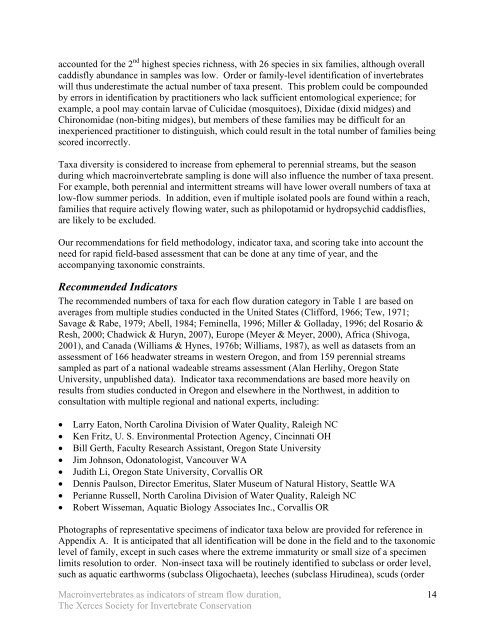Using Aquatic Macroinvertebrates as Indicators of Stream Flow ...
Using Aquatic Macroinvertebrates as Indicators of Stream Flow ...
Using Aquatic Macroinvertebrates as Indicators of Stream Flow ...
You also want an ePaper? Increase the reach of your titles
YUMPU automatically turns print PDFs into web optimized ePapers that Google loves.
accounted for the 2 nd highest species richness, with 26 species in six families, although overallcaddisfly abundance in samples w<strong>as</strong> low. Order or family-level identification <strong>of</strong> invertebrateswill thus underestimate the actual number <strong>of</strong> taxa present. This problem could be compoundedby errors in identification by practitioners who lack sufficient entomological experience; forexample, a pool may contain larvae <strong>of</strong> Culicidae (mosquitoes), Dixidae (dixid midges) andChironomidae (non-biting midges), but members <strong>of</strong> these families may be difficult for aninexperienced practitioner to distinguish, which could result in the total number <strong>of</strong> families beingscored incorrectly.Taxa diversity is considered to incre<strong>as</strong>e from ephemeral to perennial streams, but the se<strong>as</strong>onduring which macroinvertebrate sampling is done will also influence the number <strong>of</strong> taxa present.For example, both perennial and intermittent streams will have lower overall numbers <strong>of</strong> taxa atlow-flow summer periods. In addition, even if multiple isolated pools are found within a reach,families that require actively flowing water, such <strong>as</strong> philopotamid or hydropsychid caddisflies,are likely to be excluded.Our recommendations for field methodology, indicator taxa, and scoring take into account theneed for rapid field-b<strong>as</strong>ed <strong>as</strong>sessment that can be done at any time <strong>of</strong> year, and theaccompanying taxonomic constraints.Recommended <strong>Indicators</strong>The recommended numbers <strong>of</strong> taxa for each flow duration category in Table 1 are b<strong>as</strong>ed onaverages from multiple studies conducted in the United States (Clifford, 1966; Tew, 1971;Savage & Rabe, 1979; Abell, 1984; Feminella, 1996; Miller & Golladay, 1996; del Rosario &Resh, 2000; Chadwick & Huryn, 2007), Europe (Meyer & Meyer, 2000), Africa (Shivoga,2001), and Canada (Williams & Hynes, 1976b; Williams, 1987), <strong>as</strong> well <strong>as</strong> dat<strong>as</strong>ets from an<strong>as</strong>sessment <strong>of</strong> 166 headwater streams in western Oregon, and from 159 perennial streamssampled <strong>as</strong> part <strong>of</strong> a national wadeable streams <strong>as</strong>sessment (Alan Herlihy, Oregon StateUniversity, unpublished data). Indicator taxa recommendations are b<strong>as</strong>ed more heavily onresults from studies conducted in Oregon and elsewhere in the Northwest, in addition toconsultation with multiple regional and national experts, including:• Larry Eaton, North Carolina Division <strong>of</strong> Water Quality, Raleigh NC• Ken Fritz, U. S. Environmental Protection Agency, Cincinnati OH• Bill Gerth, Faculty Research Assistant, Oregon State University• Jim Johnson, Odonatologist, Vancouver WA• Judith Li, Oregon State University, Corvallis OR• Dennis Paulson, Director Emeritus, Slater Museum <strong>of</strong> Natural History, Seattle WA• Perianne Russell, North Carolina Division <strong>of</strong> Water Quality, Raleigh NC• Robert Wisseman, <strong>Aquatic</strong> Biology Associates Inc., Corvallis ORPhotographs <strong>of</strong> representative specimens <strong>of</strong> indicator taxa below are provided for reference inAppendix A. It is anticipated that all identification will be done in the field and to the taxonomiclevel <strong>of</strong> family, except in such c<strong>as</strong>es where the extreme immaturity or small size <strong>of</strong> a specimenlimits resolution to order. Non-insect taxa will be routinely identified to subcl<strong>as</strong>s or order level,such <strong>as</strong> aquatic earthworms (subcl<strong>as</strong>s Oligochaeta), leeches (subcl<strong>as</strong>s Hirudinea), scuds (order<strong>Macroinvertebrates</strong> <strong>as</strong> indicators <strong>of</strong> stream flow duration,The Xerces Society for Invertebrate Conservation14
















